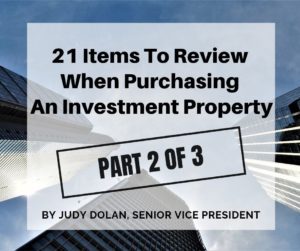21 Items to Review When Purchasing an Investment property- Part 2

In the first part of this three part blog, I noted seven items that you should review when purchasing an investment property. This is part 2 of the list, adding seven additional items, in no particular order:
- Municipal Lien Search: Invest in a municipal lien search report. There are companies that will get a report from the municipalities showing any outstanding code violations, open permits, outstanding fines or other pending items for the particular property. Outstanding permits or open permits can create an unexpected financial expense in the future. These should be cleared prior to purchasing the property. Outstanding fees or fines should also be cleared prior to closing. The utilities costs should be paid in full as of the closing date.
- Tenant Interviews: Take the opportunity to meet the tenants at the property. Ask them if they know of any maintenance issues. Ask them if they know of any issues at the property. Ask them if they are renewing their leases or if they are looking at new locations. You can learn a lot about a property and any issues by speaking directly to the tenants.
- Visual Observation of the Property: Go to the property on several occasions at various times of the day. If it’s a rainy day, observe the drainage. Does the parking area flood? Does the street flood leading to the driveway of the property? Are there any concerns about the property? Are there vagrants that create a nuisance at the property? Did you observe the property in the evening? Is the parking area well lit? Are all the lights in the parking area in good working condition? Does the dumpster area look like it is a tempting place to dump garbage that isn’t generated by the tenants of the property? If there are areas of concern, can they be corrected? If not, can you live with them or will they affect the leasing potential of the property?
- Income/Expense History: Obtain the historical income/expense information. The ideal time frame would be for the prior three years. If that is not available, you should at least have the last calendar year and year to date information. Look at the income. Does it match the lease rates? Is it less than the lease rates? If so, is there a collection problem or are the leases new? Review the expenses. Are they accurate? If you are able to do so, compare actual invoices for the work completed to the costs listed on the expense report. Read the invoices for the expenses. The detail may indicate some deferred maintenance issues, for instance, does the seller pay for multiple repairs for an item when it should be replaced. When doing your numbers, adjust the real estate taxes based on the assessment based on the new purchase price, base the insurance expenses on your level of coverage. These two items can create a large variance in the net operating income. Understand what Income/Expense information is provided. You want to review actual information, not pro forma information.
- Area Rental Rates: Do you know what the rents are at the surrounding properties? Does the sale package have rent comps? If so, are they accurate? Call surrounding properties, find out their rental rates, do they have any space vacant? How long has the space been vacant? If there are vacant spaces in the building you are purchasing, how long have the spaces been vacant? Are the asking rents market or are they higher than market to make it look like the building will perform better than it should? Are the higher than market rates for very small spaces that the landlord is using as an example of what the rental rates could be? These may not be accurate numbers and may be put in place to create the illusion of higher rates than the market. This may set the buyer’s expectation for new and higher rents which may never be achievable.
- Planned Redevelopment or Improvements Near the Property: Meet with the municipality and ask if there are any planned redevelopments or improvements near the property. This may affect the value of the property. This could be a positive or a negative. If the area is booming, that could be great for the property values. If there is going to be a road work project starting in the next several months that will last for 3 years, it may negatively affect your property in the short term but may be beneficial in the long term. Are you able to wait for the rebound? Do you have the financial strength to do that?
- Floor Plans/Space Plans: If there are plans available for the building, review them. Do the spaces have the same layout as on the plans? Are the sizes on the plans? Do the sizes of the suites/spaces on the plans match the sizes of the suites/spaces in the leases? If there is a difference, are they larger or smaller? You may want to invest in as-built space plans. There are several companies that will measure the spaces and draw the as-built space plans at a reasonable price.
The final seven items will appear in the next blog.









